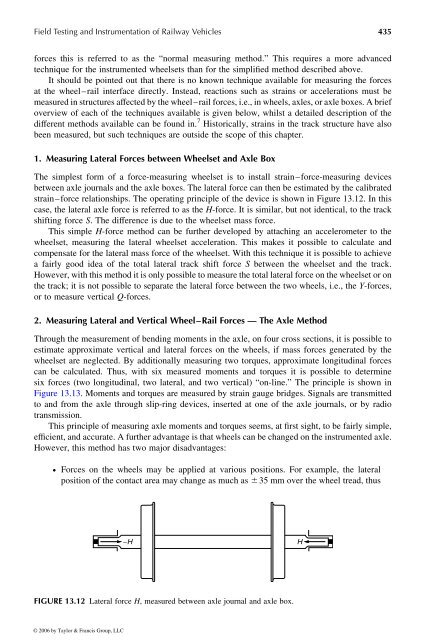Create successful ePaper yourself
Turn your PDF publications into a flip-book with our unique Google optimized e-Paper software.
Field Testing and Instrumentation <strong>of</strong> <strong>Railway</strong> <strong>Vehicle</strong>s 435<br />
forces this is referred to as the “normal measuring method.” This requires amore advanced<br />
technique for the instrumented wheelsets than for the simplified method described above.<br />
It should bepointed out that there is no known technique available for measuring the forces<br />
at the wheel–rail interface directly. Instead, reactions such as strains oraccelerations must be<br />
measured in structures affected by the wheel–rail forces, i.e., in wheels,axles, or axle boxes. Abrief<br />
overview <strong>of</strong> each <strong>of</strong> the techniques available is given below, whilst adetailed description <strong>of</strong> the<br />
different methods available can be found in. 7 Historically, strains in the track structure have also<br />
been measured, but such techniques are outside the scope <strong>of</strong> this chapter.<br />
1. Measuring Lateral Forces between Wheelset and Axle Box<br />
The simplest form <strong>of</strong> aforce-measuring wheelset is to install strain–force-measuring devices<br />
between axle journals and the axle boxes. The lateral force can then be estimated by the calibrated<br />
strain–force relationships. The operating principle <strong>of</strong> the device is shown inFigure 13.12. Inthis<br />
case, the lateral axle force isreferred to as the H -force. It is similar, but not identical, to the track<br />
shifting force S .The difference is due to the wheelset mass force.<br />
This simple H -force method can be further developed by attaching an accelerometer tothe<br />
wheelset, measuring the lateral wheelset acceleration. This makes it possible to calculate and<br />
compensate for the lateral mass force <strong>of</strong>the wheelset. With this technique it is possible toachieve<br />
afairly good idea <strong>of</strong> the total lateral track shift force S between the wheelset and the track.<br />
However, with this method it is only possible to measurethe total lateral force on the wheelset or on<br />
the track; it is not possible to separate the lateral force between the two wheels, i.e., the Y -forces,<br />
or to measure vertical Q-forces.<br />
2. Measuring Lateral and Vertical Wheel–Rail Forces —The Axle Method<br />
Through the measurement <strong>of</strong> bending moments in the axle, on four cross sections, it is possible to<br />
estimate approximate vertical and lateral forces on the wheels, if mass forces generated by the<br />
wheelset are neglected. By additionally measuring two torques, approximate longitudinal forces<br />
can be calculated. Thus, with six measured moments and torques it is possible todetermine<br />
six forces (two longitudinal, two lateral, and two vertical) “on-line.” The principle is shown in<br />
Figure 13.13. Moments and torques are measured by strain gauge bridges. Signals are transmitted<br />
to and from the axle through slip-ring devices, inserted at one <strong>of</strong> the axle journals, or by radio<br />
transmission.<br />
This principle <strong>of</strong> measuring axle moments and torques seems, at first sight, to be fairly simple,<br />
efficient, and accurate. Afurther advantage is that wheels can be changedonthe instrumented axle.<br />
However, this method has two major disadvantages:<br />
† Forces on the wheels may be applied at various positions. For example, the lateral<br />
position <strong>of</strong> the contact area may change as much as ^ 35 mm over the wheel tread, thus<br />
− H H<br />
FIGURE 13.12 Lateral force H ,measured between axle journal and axle box.<br />
© 2006 by Taylor & Francis Group, LLC









